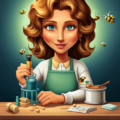Learning basic chemistry concepts doesn’t have to be a daunting task. In fact, it can be quite fun when introduced through hands-on experiments and craft activities. One such exciting way is through soap making recipes, which not only provide a practical application of STEM (Science, Technology, Engineering, Mathematics) concepts but also result in a useful product that kids can take pride in.
Soap making is essentially a chemical reaction between fats or oils and lye. The process is known as saponification. As complex as it sounds, it’s pretty straightforward and an excellent way for kids to learn about chemical reactions, measurement, and the properties of different substances.
Creating soap involves measuring ingredients accurately, which reinforces mathematical concepts. The process also requires understanding the chemical reaction between lye and fat/oil, which brings in the science aspect. The design and creation of the soap molds involve engineering skills, while the use of different tools and techniques introduces technology.
To start with, here’s a simple soap making recipe suitable for beginners:
Ingredients:
- 1 cup of pure coconut oil (solid at room temperature)
- 0.3 pounds of lye
- 1 cup distilled water
Instructions:
- Wearing eye protection and rubber gloves, slowly add the lye to the water (never the other way around) in a well-ventilated area.
- Stir until dissolved and set aside to cool.
- Melt the coconut oil in a separate container.
- Once both mixtures are at room temperature (around 100-110°F), slowly pour the lye solution into the oil while stirring.
- Continue stirring until the mixture thickens to a pudding-like consistency.
- Pour into mold(s) of your choice and let it sit for 24 hours.
- Unmold and cut into bars, then let them cure for 4-6 weeks.
Remember to always supervise children during this activity due to the use of lye, which is caustic before saponification.
This simple soap-making experiment introduces children to various STEM concepts like states of matter (solid, liquid), chemical reactions (saponification), measurements (weight, temperature), safety precautions, etc.
On top of soap making, there are many other craft activities that can be used to introduce STEM concepts to children. For example:
Building Bridges: Using toothpicks and marshmallows or straws and tape, children can learn about engineering principles like tension and compression.
Creating Slime: This fun activity involves combining glue with borax solution to create a non-Newtonian fluid – a substance that acts both like a liquid and a solid!
Designing Paper Airplanes: A classic activity where kids can learn about aerodynamics and trial-and-error testing.
Building Volcanoes: Using baking soda and vinegar, kids can create their own mini volcanic eruption while learning about chemical reactions.
Making Crystal Geodes: By dissolving borax or sugar in hot water and leaving it to cool around a seed crystal, children can observe how crystals form over time.
These hands-on experiments not only make learning fun but also help kids understand abstract concepts better by seeing them in action. So why wait? Get started with these exciting projects today and introduce your child to the fascinating world of STEM through craft!


